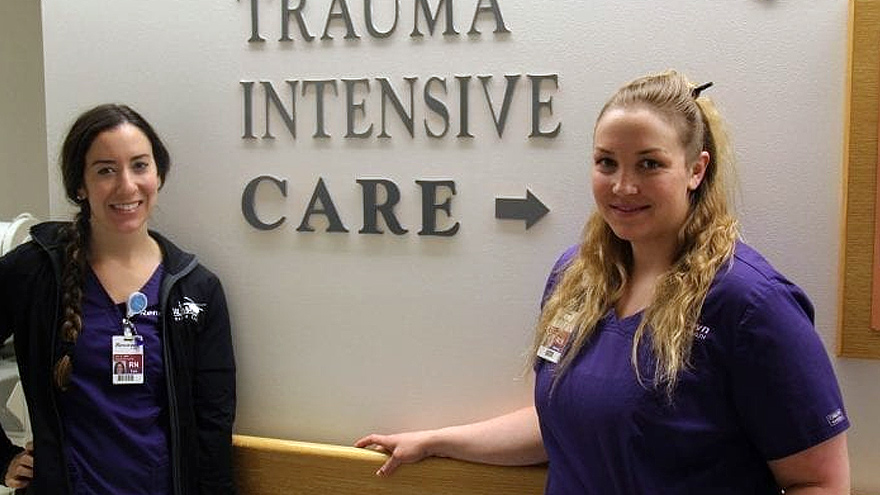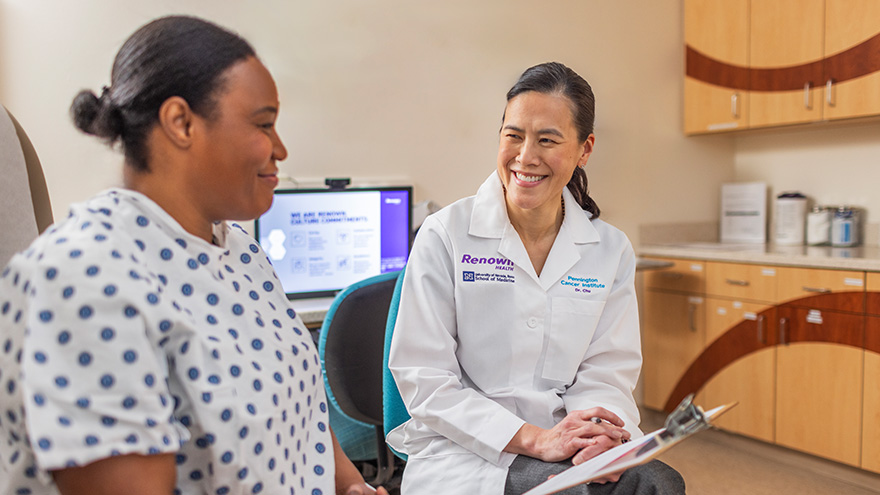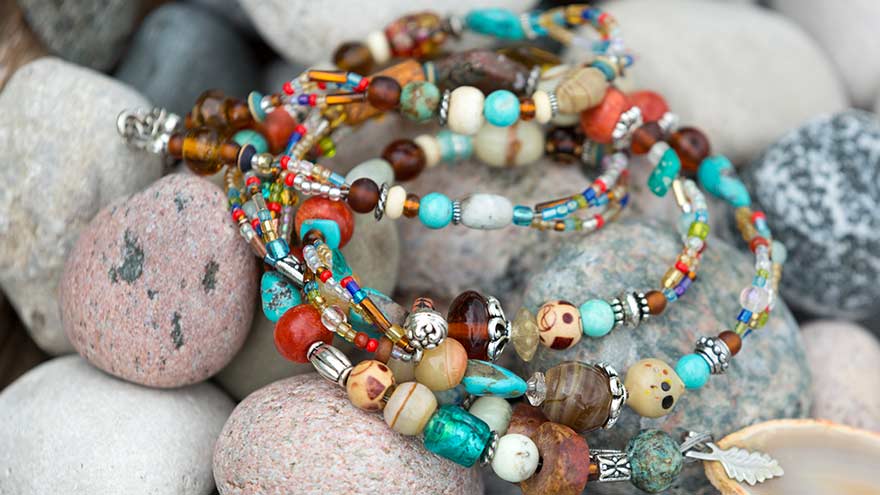Search
Results for 'what is an'
Clear-
Caring for the Whole Family: Renown Nurse Helps Patient with Ailing Pet
Registered Nurse Tori Tembey (left) shared how her co-worker and fellow RN Jennifer Payne helped a patient with his pet's end-of-life arrangements. "It was such a selfless act that Jennifer took the time to do this for the patient.” Tembey says. Pets become members of our own family, and when they are ill or at the end of their lives, it can be devastating for their owners. During a hospital stay, a Renown patient was faced with the difficult decision to euthanize their terminally ill pet. A Renown registered nurse stepped in to help in some pretty remarkable ways. Back in high school, Jennifer Payne wanted to be a veterinarian. She worked in a veterinary hospital and planned to attend veterinary school, but struggled with some of the situations she faced. “I have a lot of compassion for animals,” Payne explains. “And some of the things I saw while working at the vet — like people bringing in their cat saying, ‘I’m moving, you need to put this cat down’ — wasn’t OK with me, and wasn’t what I wanted to do.” She changed course and went into nursing, but recently drew upon her early experiences working with pets and their owners to help a Renown patient in an extraordinary way. Payne now works in the trauma intensive care unit at Renown Regional Medical Center, where she recently observed a county animal control officer visiting a patient. The patient was visibly upset — they learned their dog was terminally ill and in poor health, and a veterinarian was recommending euthanasia. The patient had lost another dog just before Christmas. The patient hoped to have his ill dog similarly cremated, but animal control does not perform cremation. “I overheard all of this and thought, ‘this is the most horrible thing I’ve ever heard,’” Payne says. She offered to pick up the dog, have him cremated and bring the ashes to the patient. She also took up a collection with her Renown colleagues to pay for the cremation. The next day — her day off — Payne and her young daughter picked up the ashes and brought them to the patient at the hospital. “He couldn’t even talk because he was crying so much,” Payne says. “He said ‘I can’t thank you enough for all you’ve done. You’re a wonderful person.’ There was a friend in the room who asked what my daughter’s name was, and I said ‘Estelle.’ The friend said, ‘Estelle, your mother is an angel.’” Payne, who has a golden retriever of her own, says she knows what it’s like to have “fur babies,” and she could see how important this dog was to the patient. “It was great to be able to do this for him,” she says. Renown salutes nurses like Jennifer Payne, who are making a genuine difference everyday in the lives of patients and in the community.
Read More About Caring for the Whole Family: Renown Nurse Helps Patient with Ailing Pet
-
Guide to Cancer Screenings
One of the most crucial aspects of maintaining health and wellness is staying proactive about regular cancer screenings. Early cancer detection significantly increases the chances of successful treatment and survival. The multidisciplinary care team at the William N. Pennington Cancer Institute at Renown Health provides compassionate care and support to the community for early detection and diagnoses. This comprehensive guide outlines the various cancer screenings available for breast, colorectal, lung, cervical, prostate and skin cancer. Breast Cancer Screening Who Should Get Screened? Mammograms are recommended starting age 40 for those considered at average risk for breast cancer. Women with a family history or other risk factors should discuss appropriate screening options with their healthcare provider. Women under 40 with a family history should discuss risk factors with a healthcare provider. Screening Methods Mammogram: This provides an X-ray of the breast and can detect tumors that are not yet palpable. Breast MRI: This type of scan is recommended for women at high risk for breast cancer due to genetic factors or family history. Screening Breast Ultrasound: This scan can help in identifying masses in denser breast tissue that might not be visible on mammogram. It is recommended in addition to a mammogram for patients at a higher risk for breast cancer. What to Expect During a mammogram, the breast is compressed between two plates to capture X-ray images. Some pressure or discomfort may be felt, but the procedure is brief and critical for early detection. Colorectal Cancer Screening Who Should Get Screened? Adults aged 45 to 75 should undergo regular colorectal screenings. Some adults under 45 may need to be screened earlier depending on family history or other genetic risks. Those over 75 should consult with their healthcare provider to determine if continued screening is necessary. Screening Methods Colonoscopy: This procedure uses a flexible tube with a camera to examine the entire colon. Fecal Immunochemical Test (FIT): A non-invasive test that detects hidden blood in the stool. CT Colonography (Virtual Colonoscopy): Uses Computed tomography (CT) imaging to provide detailed views of the colon. What to Expect A colonoscopy can detect changes or abnormalities in the large intestine (colon) and rectum. Screening is usually advised every ten years, but if you are at risk, screening may be recommended every 3 to 5 years after your initial colonoscopy. Colonoscopy preparation includes bowel cleansing the day before and sedation during the procedure. FIT is a simple at-home test requiring no special preparation. Lung Cancer Screening Who Should Get Screened? Adults aged 50 to 80 with a significant smoking history (20 pack years or more) and who currently smoke or have quit within the past 15 years. Screening Methods Low-dose Computed Tomography (LDCT): A CT scan with low radiation doses to create detailed images of the lungs. What to Expect LDCT is a non-invasive scan that requires you to hold your breath for a few seconds. Cervical Cancer Screening Who Should Get Screened? Women aged 21 to 65 should undergo regular screenings. Women aged 21 to 29 should have a Pap test every three years. Women aged 30 to 65 should have a Pap test and HPV test every five years, or a Pap test alone every three years. Screening Methods Pap Test (sometimes called a Pap Smear): Collects cells from the cervix to detect precancers. HPV Test: Identifies high-risk human papillomavirus (HPV) types that can cause cervical cancer. What to Expect The Pap test involves collecting cells from the cervix using a small brush. Some discomfort may be felt, but the procedure is brief and crucial for early detection. Prostate Cancer Screening Who Should Get Screened? Men aged 50 and older should discuss screening options with their healthcare provider. Men at higher risk (African American men and those with a family history of prostate cancer or are a BRCA2 gene carrier) should begin discussing screenings at age 40. Screening Methods Prostate-Specific Antigen (PSA) Test: Measures PSA levels in the blood. Digital Rectal Exam (DRE): A physical examination where the provider feels the prostate through the rectum to detect abnormalities. What to Expect The PSA test is a simple blood test. The DRE may cause slight discomfort but is quick and essential for early detection. Skin Cancer Screening Who Should Get Screened? Anyone with a suspicious lesion or abnormal area on their skin. Individuals with more than 50 moles or dysplastic moles. Those with a personal history of melanoma or history of other skin cancers. Those who have more than one member of immediate family with a history of cancers (melanoma, breast cancer, pancreatic cancer) or a family member who was diagnosed with melanoma before they were 50 years old. Positive gene testing for BRACA2, Lynch syndrome genes (MLH1, MSH2, MSH6, PMS2 or EPCAM). Screening Methods Skin Exam: A visual examination by your provider to check for unusual moles, birthmarks, or other skin changes. Biopsy: Removal of a small sample of skin for testing if an abnormal area is identified. What to Expect A skin exam is non-invasive and visual. A biopsy involves minor discomfort and local anesthesia if needed. Expert Advice Although the cadence of these skin screenings may or may not be annual, as one's age increases, the risk of many cancers rises. Everyone benefits from attentive sun protection, including avoiding direct sun between 10 a.m. and 4 p.m. by seeking shade and wearing hats, clothing and sunscreen. When purchasing sunscreen, look for SPF 50, UVA/UVB broad spectrum. Questions to Discuss with Your Healthcare Provider What is my risk level for different types of cancer? Which screening tests do you recommend for me and why? What are the potential risks and benefits of each test? How often should I get screened? What steps to follow if a test result is abnormal? Importance of Cancer Screenings Regular cancer screenings are vital for maintaining your health and catching cancer early, when it is most treatable. Renown Health is dedicated to guiding you through the process and providing the highest quality of care. Consult with your healthcare provider to determine the appropriate screenings for your specific needs and to take proactive steps toward a healthier future.
-
Guide for Self Breast Awareness
What is a Breast Self-Exam? A breast self-examination is a technique used to check for early signs of potential breast health complications. This physical and visual examination typically only takes a few minutes. Performing monthly self-exams helps you become more familiar with the normal appearance and texture of your breasts, making it easier to recognize any changes during future exams. While monthly self-exams are helpful, it’s important to get an annual mammogram even if you don’t notice anything. Mammograms help provide a 3D scan of the breast tissues, detecting changes that may not be felt during a self-exam. Dr. Cristin Newkirk-Thompson, an MD with Renown Health, discusses the protocols and importance of self-breast awareness. How to Perform a Self-Breast Exam Use the pads of your fingers and move them in a circular motion. Cover the entire breast area from top to bottom, side to side—from your collarbone to the top of your abdomen, and from your armpit to your cleavage. Follow a pattern: circular, wedge, or vertical line, ensuring you cover all tissue. Use varying pressure: light pressure for tissue just beneath the skin, medium pressure for the middle of the breasts, and firm pressure for deep tissue. There are multiple ways to perform a self-breast exam including: Visual Inspection: Stand in front of a mirror with your shoulders straight and your hands on your hips or to your side. This is when you look for any abnormalities or changes. Lying Down: Lying down spreads the breast tissue evenly over the chest wall, making it easier to feel all areas. In the Shower: Many women find it easiest to feel their breasts when their skin is wet and slippery, so you might want to perform this step in the shower. What to Look For Changes in density, size, shape, or symmetry. Dimpling, puckering, or bulging of the skin. Nipple changes such as inversion or discharge. Redness, soreness, rash, or swelling. When to Perform a Self-Breast Exam It’s recommended to perform self-breast exams monthly, a few days after the end of your period. For women in menopause or those who have irregular periods, the specific day isn’t as important, if it is consistent. What to do if You Find a Lump If you notice any new changes with your breasts, don’t panic; there can be several reasons why breasts have changed. It’s best to follow up with your provider to be as proactive as possible. Additional recommended screenings for further examination can be scheduled to have a clearer answer.
-
Top 3 Cholesterol Questions Answered
With more than 29 million adult Americans having high cholesterol, it’s important to know the facts. We asked Jayson Morgan, MD, a cardiologist with Renown Institute for Heart and Vascular Health, explains the numbers, the risk factors and how to maintain healthy levels. What is cholesterol? There are two types: Low-density lipoprotein (LDL) cholesterol, also known as the “bad” variety, because it can eventually build up within the walls of your blood vessels and narrow the passageways. High-density lipoprotein (HDL), also known as the “good” variety, because it helps remove other forms of cholesterol from the bloodstream. In adults, total cholesterol is considered high if it is more than 200 mg/dL. If the total is more than 200 or if high-density lipoprotein (HDL) levels are less than 40, your heart and brain may not be getting as much oxygen-rich blood as they need. This puts you at greater risk of heart attack and stroke. HDL levels greater than 60 mg/dL can actually lower your risk. What are the risk factors for high levels? Diet high in saturated fat Excess body weight Lack of exercise Smoking Family history Age (as people age, they are more prone to high levels) How often should someone get their numbers checked, and what kind of test is done? The American Heart Association recommends all adults age 20 or older have their cholesterol checked every four to six years. Those with cardiovascular disease or who are at higher risk of it may need their levels and other risk factors assessed more often. Your primary care provider can perform the test, along with assessing your other risk factors to help determine a treatment plan if necessary. The test will likely be one you will need to fast for, meaning no food, beverages or medications for around nine to 12 hours. Your healthcare provider will let you know if, and for how long, to fast. A simple blood test is all that’s needed to get your levels. What are some ways to lower “bad” cholesterol and raise “good” cholesterol? To achieve healthier levels, people should: Eat a heart-healthy diet: Choose healthier fats, eliminate trans fats, eat foods rich in omega-3 fatty acids and increase soluble fiber. Increase physical activity: Exercise on most days of the week. Quit smoking: If you smoke, it’s time to stop. Quitting smoking will improve HDL “good” cholesterol levels. Lose weight: Losing as little as five to 10 percent of your weight can improve cholesterol levels. Drink alcohol only in moderation. And finally, if lifestyle changes aren’t enough, your care provider might recommend medication to help lower your numbers. Renown Institute for Heart & Vascular Health For optimal heart health, the American Heart Association encourages you to “Know Your Numbers” which include: blood pressure, body mass index (BMI), cholesterol and fasting blood sugar, by scheduling a visit with your doctor. These numbers are critical in assessing your current risk for heart disease and stroke. Find a Cardiologist
-
From Cancer Survivor to Caregiver
Meet Haley Carroll Being a new nurse comes with many challenges and gaining experience is a journey, but Haley Carroll’s first day on the job was far from her first day in a hospital. Haley was diagnosed with lymphoma right before her senior year of high school, and she was declared cancer-free on December 2, 2015. Inspired by the incredible care she received during her cancer treatments and during her time at Renown Children’s Hospital, Haley enrolled in nursing school at the University of Nevada, Reno. She graduated in December 2020, just five years after beating cancer. “I’ve always been interested in nursing,” Haley says. “But once I was diagnosed and began to see everything that my nurses did for me, I knew that that’s what I wanted to do for patients, too.”
-
Get Ready for Baby with Childbirth Classes
By taking our pregnancy and birth class, you will gain the tools necessary to have a safe and empowering birth experience for both you and your baby. Chris Marlo, Childbirth Educator at Renown Health explains why birth classes are important. For questions regarding classes or tours, contact Chris Marlo: chris.marlo@renown.org 775-982-4352 What is a Certified Childbirth Educator/Doula? If you are expecting a baby, Renown has a wide variety of classes to help prepare you for birth. Classes are taught by certified childbirth educators and doulas. A certified childbirth educator is a trusted resource who has a passion for educating expecting parents about childbirth, and will provide you with non-biased, evidence-based information. A doula is a professional labor assistant who provides physical and emotional support during pregnancy, childbirth and postpartum. As you prepare for birth, our certified educators will guide you each step of the way and ensure you receive the quality care you deserve.
-
Healthy Veggie Chili, Ready to Eat in Less than an Hour? Yes Please!
We’re always in search of cozy comfort foods for crisp winter evenings, but you know what’s even better? When the recipe takes less than an hour, start to finish. Here’s a recipe for healthy vegetarian chili that you can customize with your favorite beans. Remember those Choose Your Own Adventure books you used to read as a child? Well here’s a Choose-Your-Own-Adventure-inspired veggie chili. The adventure: Customizing it with your favorite beans! And once your selections are made and the veggies are chopped, this recipe should take about 40 minutes to prepare, from beginning to satisfying end. Vegetarian Chili Feeds the Crowds Here’s the recipe, which is fully customizable based on bean preferences and can also be adapted to slow cooking.
Read More About Healthy Veggie Chili, Ready to Eat in Less than an Hour? Yes Please!
-
Handmade Bracelets a Labor of Love for Cancer Patients
The road through cancer treatment can test even the toughest of spirits. A local organization is handcrafting and donating beaded bracelets to the courageous women who have reached the finish line at Renown Infusion Services. After finishing her sixth and final cycle of chemotherapy at Renown Infusion Services, Joan Jackson told her nurse, Daun Russell, RN, she was tired. Russell returned with a box and opened it -- as she does for all cancer patients completing treatment -- and said, “pick one.” What Jackson was selecting was a beautiful, handmade bracelet crafted and donated by the local Soroptimist organization. Jackson picked a purple bracelet with a tag that read, "Congratulations on completing your treatment. Imagine what you can do now." “Picking the bracelet was such a special thing to mark my last day of chemo,” Jackson says. "Their gesture impacted me for the good after going through so much.” The women behind the bracelets Bev Perkins, a member of the Soroptimist International of Truckee Meadows, says the bracelet project began in 2009 as a way of celebrating those who completed cancer treatment. She wanted the project to be hands-on, so she involved the club members by organizing a small budget and asking others to donate jewelry. The group comes together each year to make the bracelets. Perkins disassembles the donated jewelry, adding newly purchased beads to make kits for the bracelets. The volunteers also add a metal tag inscribed with an inspiring word, like “believe,” “hope” or “love.” “It’s a labor of love for us,” says Kay Dumhan, group treasurer. “It’s to show empowerment and to help these women know there are people who are encouraged by them.” “When bracelets are donated there is usually quite a bit of feedback on how much it’s appreciated,” Dumhan says. “We never want to run out so we make sure we have a supply there. We’ve had cancer survivors as members and that makes it all the more personal.”
Read More About Handmade Bracelets a Labor of Love for Cancer Patients
-
5 Easy Food Tips for Healthier More Beautiful Skin
What should you be eating for more radiant, youthful, beautiful skin? The answers may surprise you. Here’s insight from a medical aesthetician about what to eat, and what to avoid. Perhaps nowhere is the common refrain “You are what you eat” more clearly reflected than in your skin. The body’s largest organ — your skin — basically tells a tale of the foods you feed your body. So do more than apply the right creams and serums: Feed it the right foods! Here, Heidi Nicol, medical aesthetician with Renown Dermatology, Laser & Skin Care, walks us through which foods to eat and which to avoid for a healthy glow. Start with Fruits and Vegetables Fruits and vegetables are full of vitamins, minerals and antioxidants, which give them their brilliant colors. Eating a wide array of colorful fruits and vegetables will provide the necessary protection against cellular oxidation and the production of cancer cells. Avoid Sugar When you consume sugary food, the sugar in your bloodstream attaches to proteins like collagen and elastin fibers. This process, called glycation, forms harmful new molecules. This is important to note because these fibers keep skin firm and elastic. Once damaged, those fibers become hard, brittle and dry. What does this mean for your skin? This glycation process can actually age us, causing wrinkles, age spots, uneven skin tone and other negative effects. Beautiful Skin Vitamins A nutritious diet is essential to the maintenance of overall health and radiant skin. Consuming certain vitamins, minerals and other beneficial compounds is one of the best ways to improve its look and feel. Here are several universally-recognized essentials and a few of their common sources: • Vitamin A: Cod liver oil, cream, butter and egg yolks • Zinc: Liver, red meat, seafood, shellfish and pumpkin seeds • Vitamin C: Citrus fruits, bell peppers, dark leafy greens and broccoli • Omega-3 fatty acids: Salmon, tuna, walnuts, olive oil and flax seeds • Biotin: Egg yolks, liver, swiss chard, almonds and walnuts • Selenium: Chicken, beef, pork, cheese, sunflower seeds, brown rice, tuna and spinach • Silica: Leeks, green beans, garbanzo beans, strawberries, cucumber, mango and celery • Niacin: Red meat, poultry, tuna, salmon, seeds, milk, dark leafy vegetables, coffee and tea • Vitamin K12: Butter, egg yolks, liver, sauerkraut and cheese • Probiotics: Yogurt, kefir and fermented foods • Vitamin E: Soybeans, canola, corn and other vegetable oils, spinach, turnips, chard, sunflower seeds, almonds and bell peppers • Vitamin B5: Broccoli, tomatoes, strawberries, yogurt and whole wheat A nutrient-rich diet with these vitamins, minerals and other compounds will be a powerful tool in treating skin problems leading to a vibrant glow. Avoid Alcohol Drinking alcohol can cause enlarged blood vessels, burst capillaries, flushing, redness and angiomas (small, red moles). In addition, alcohol dehydrates your body, which makes skin appear less plump and fresh. Alcohol also breaks down the immune system, and the extra sugar in alcohol causes system inflammation, which contributes to cell damage and skin aging. To help combat some of these effects, be sure to alternate alcoholic drinks with water, which will help prevent you from getting too dehydrated. Drink Plenty of Water Speaking of water, an increase in wrinkles is a common response to lack of moisture. When cells are not fully hydrated by water (and water-rich foods), they cannot function properly. If you are not getting enough water, your skin turns dry, tight and flaky, and lines and wrinkles become more pronounced. Water aids in circulation, digestion, absorption and excretion. Proper water intake will lead to a radiant, healthy, younger looking complexion. Renown Dermatology | 775-982-8255 Renown Dermatology, Laser & Skin Care offers a comprehensive range of treatments and products to address any skin care need. Visit our beautiful office in south Reno and browse our product lines. Experts are available to answer any questions concerning your skin care and health and wellness needs. Request an Appointment
Read More About 5 Easy Food Tips for Healthier More Beautiful Skin
-
May is National Stroke Month: Know the Signs and B.E.F.A.S.T.
Every 40 seconds someone in the U.S. has a stroke, but 80 percent of all strokes are preventable. That’s why knowing the signs and symptoms and what to do is so important. With May being National Stroke Month, we asked Sadie Wangler, program manager with Renown Institute for Neurosciences, to explain more. We can prevent strokes by changing our lifestyle behaviors that increase our risk. Knowing the symptoms and being prepared to B.E. F.A.S.T. are key as well. We asked Sadie Wangler, program manager for the Renown Institute for Neurosciences, what everyone person should know about stroke. What is a stroke? A stroke can be caused by a blood clot within an artery in the brain or a blood vessel. The clot can burst due to blockage and this causes blood flow to the brain to be cut off. Without the proper bloodflow and oxygen getting to the brain, the brain’s tissue begins to die. How to spot symptoms of a stroke? The easiest thing is to remember the word “B.E.F.A.S.T.” B – Loss of balance: Ask the person to walk 5-10 feet, with light assistance, and ask if they felt dizzy or off balance. E – Double Vision or blurred vision: Ask the person if their vision has changed in any way. F – Look for face drooping: Ask the person to smile and see if one side of their face droops. A – Arm weakness: Ask the person to raise both arms. Does one arm drift downward? S – Speech difficulty: Ask the person to repeat something. Is their speech slurred or strange? T – Time to call 911: Time matters – so don’t wait to call an ambulance if you or a loved one is experiencing these symptoms. You can also watch for sudden numbness or weakness in the face, arm or leg, especially on just one side of the body. Look for any confusion — if they’re having trouble speaking or difficulty understanding others talk — and if they have trouble seeing in one or both eyes, trouble walking, dizziness, loss of balance, or sudden and unexplained severe headache. The signs of stroke happen suddenly and a lot of people may deny their symptoms, thinking they’re overreacting. But it’s critical to act quickly and get medical attention right away — when it comes to stroke and saving your brain, minutes matter. What should you do if you think you or someone you love is having a stroke? In addition to seeking help right away, it’s best to call 911 and get an ambulance. A lot of people make the mistake of driving themselves to the hospital or have someone else drive them, and this can be dangerous for a number of reasons. First of all, it can put you, your loved ones and others on the road in danger. Second, going to the hospital on your own can take more time than calling an ambulance, and when it comes to stroke, every minute of medical care counts. So it’s important to call 911 and get treatment immediately. What can you do to prevent stroke? A stroke can happen to anyone, but certain risk factors can increase your risk. There are some risk factors you can’t control: your age, family history, race and gender. Stroke risk is higher for women and people over the age of 55. Fortunately, there are some risk factors you can control, such as high blood pressure, smoking, artery or heart disease, high cholesterol, as well as obesity, poor diet and lack of exercise. A lifestyle focused on healthy diet and regular exercise can greatly reduce your risk for stroke. Quitting smoking and watching your alcohol intake can help too. The Renown Regional Medical Center has been certified as a Comprehensive Stroke Center by the Joint Commission and received the Gold Plus Achievement award by the American Stroke Association. Our Stroke Program provides evidence-based primary stroke care including evaluation, treatment and education to patients who arrive at a Renown facility with the signs and symptoms of stroke. Learn more online. Renown Institute for Neurosciences: 775-982-2970 The Renown Regional Medical Center Comprehensive Stroke Program provides evidence-based comprehensive stroke care including evaluation, treatment and education to patients who arrive at a Renown facility with the signs and symptoms of stroke. Learn more about treatment options for stroke and additional ways to reduce risk factors online. Learn More
Read More About May is National Stroke Month: Know the Signs and B.E.F.A.S.T.
-
Copays vs. Coinsurance: Know the Difference
Health insurance is complicated, but you don't have to figure it out alone. Understanding terms and definitions is important when comparing health insurance plans. When you know more about health insurance, it can be much easier to make the right choice for you and your family. A common question when it comes to health insurance is, "Who pays for what?" Health insurance plans are very diverse and depending on your plan, you can have different types of cost-sharing: the cost of a medical visit or procedure an insured person shares with their insurance company. Two common examples of cost-sharing are copayments and coinsurance. You've likely heard both terms, but what are they and how are they different? Copayments Copayments (or copays) are typically a fixed dollar amount the insured person pays for their visit or procedure. They are a standard part of many health insurance plans and are usually collected for services like doctor visits or prescription drugs. For example: You go to the doctor because you are feeling sick. Your insurance policy states that you have a $20 copay for doctor office visits. You pay your $20 copay at the time of service and see the doctor. Coinsurance This is typically a percentage of the total cost of a visit or procedure. Like copays, coinsurance is a standard form of cost-sharing found in many insurance plans. For example: After a fall, you require crutches while you heal. Your coinsurance for durable medical equipment, like crutches, is 20% of the total cost. The crutches cost $50, so your insurance company will pay $40, or 80%, of the total cost. You will be billed $10 for your 20% coinsurance.










